Troutnut
FNG
- Joined
- Sep 14, 2016
- Messages
- 82
Since moving to Washington from Alaska in 2017, I've been trying to learn how to fill the freezer with mule deer instead of caribou, which I used to backpack hunt in the Alaska Range and the Brooks Range. The first two years I hunted in Washington and was frustrated by the number of hunters on public land in the kind of semi-open country I like to hunt, and I never connected with a buck.
In 2019, I went to Idaho, still looking for my first mule deer. I started with three plans I'd researched through Google Earth, OnX, and the IDF&G website. Each plan was for a loop I could backpack over several days in remote terrain. None of the plans survived first contact with reality.
The first plan was to hunt a recent burn, up a small drainage with no official trail, where I was pretty sure I could get away from people on opening weekend.
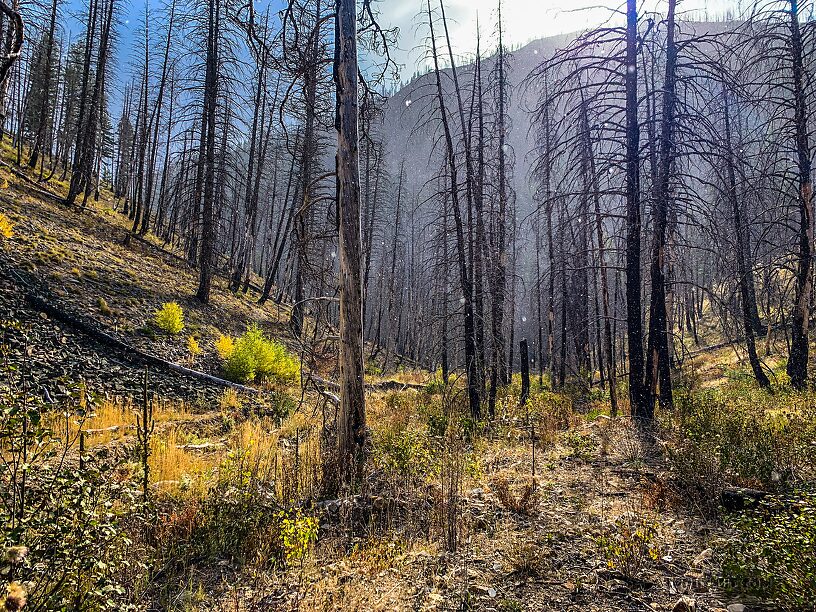
I camped the night before the opener, a few miles from the road, on a ridge with these views:
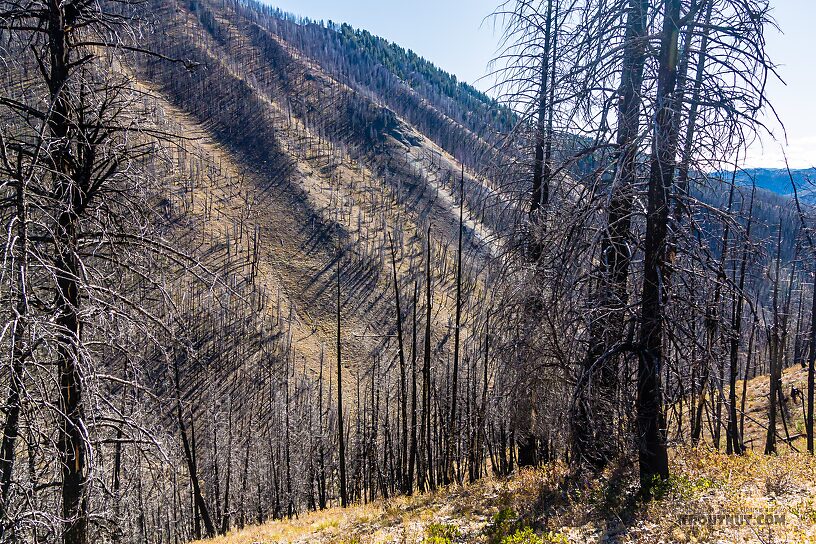
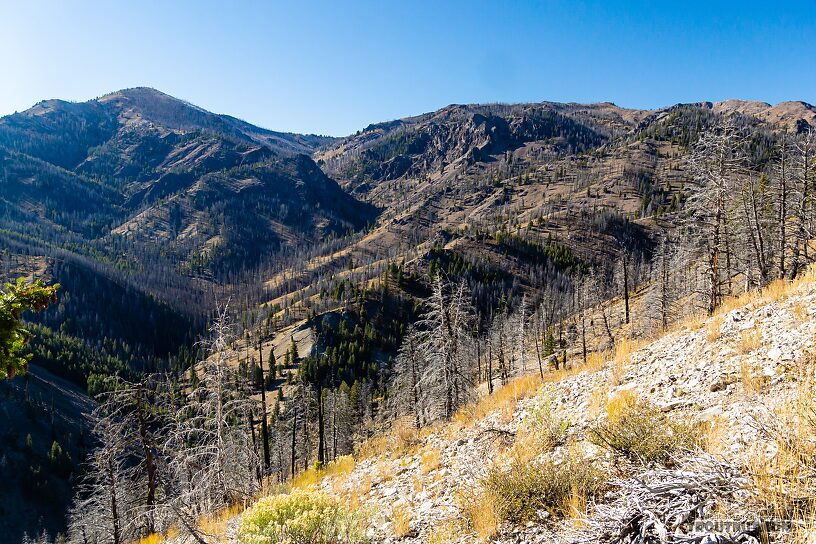
With all that country to glass at first light, I only saw two deer, too briefly to tell if either was a buck. It looked like good habitat, but deer just weren't there--only elk. That one night with temperatures near zero convinced me it was not worth backpacking all over this basin just to see two deer per day. Later on, some hunters on the other side of the mountain confirmed that I was deer hunting in an elk spot.
Maybe the lack of open patches of sagebrush was a sign that I wasn't in good mule deer country, at least in that area. Everything else seemed right. However, I realized it was not smart to commit to backpacking into an area without learning more about it deer potential than I could glean from aerial photos alone. I ditched my other two plans and spent too much time over the next few middays sitting on the computer in a restaurant, redoing my e-scouting from scratch with a focus on sampling new areas until I found deer.
The next spot I tried, just for a morning of glassing, was a small alpine basin nobody had visited yet during rifle season.
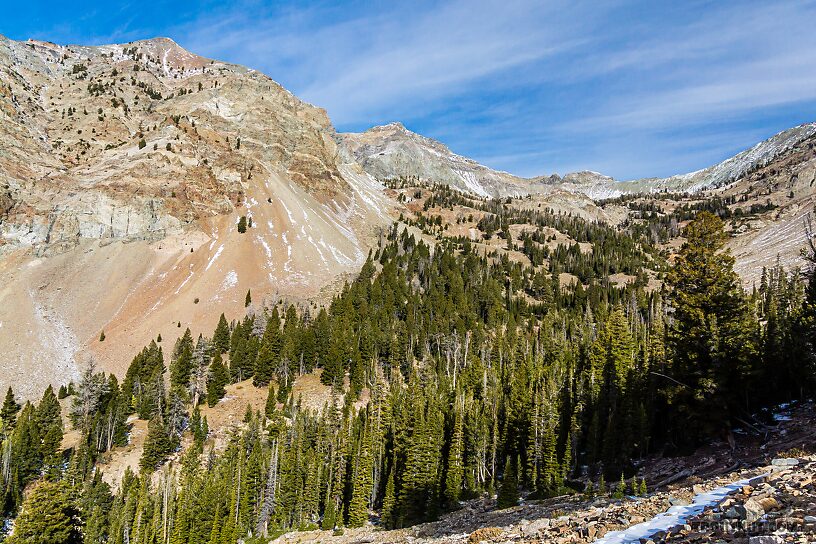
There was no sign of deer, even does, to lure me up toward the top for a better view. I drove around and scouted some more.
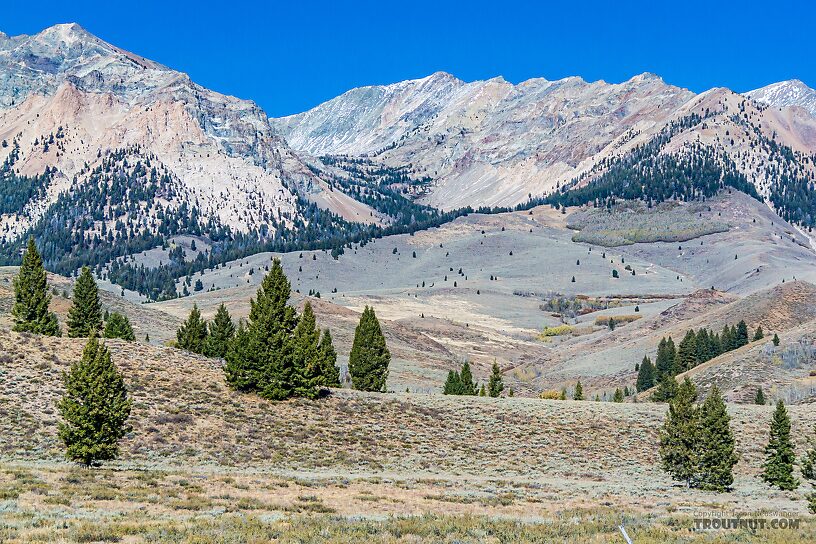
I settled on hunting an area with small mountains of open sage country with patchy evergreens. I finally started finding deer in decent numbers, mostly does.
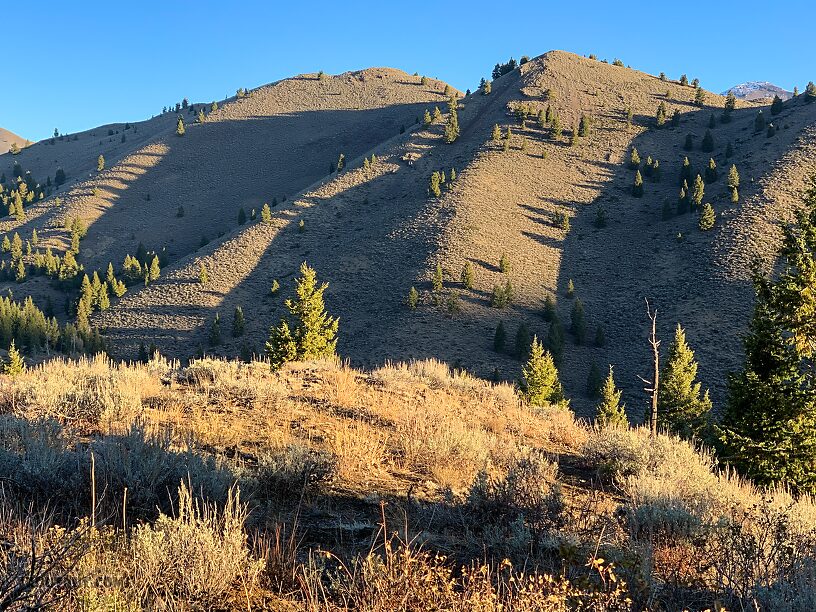
I spotted the first buck of the trip feeding in the valley near dark, and I didn't have enough shooting light to close the distance. I found him from the same spot the next morning, higher on the same ridge:
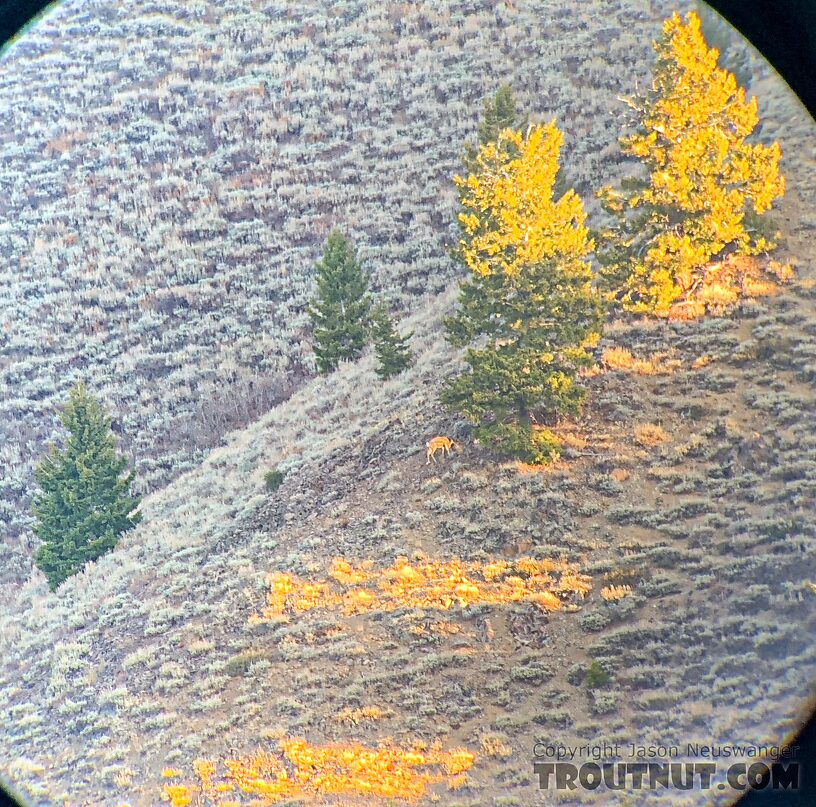
He wasn't large, just a 3x3 and maybe a big yearling, but I would be happy with any legal buck. I couldn't just walk straight at him across the valley, so I waited until the buck had disappeared behind some of those big trees and hadn't come out over over half an hour. Then I drove to a different access point and hiked three miles around the ridge to sneak up from a concealed position above the deer. Views from the ridge were nice:
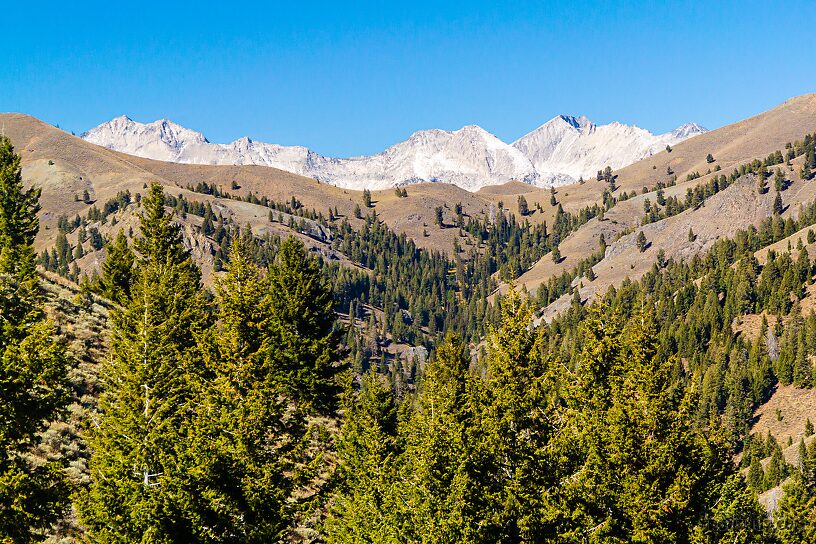
I arrived where the deer was supposed to be and snuck in quietly, removing my boots like a bowhunter, because the terrain would put me within bow range before I had a line-of-sight. The tree never saw me coming. I don't know what the buck would have seen, because it turned out he never bedded there in the first place, but had slipped away hours earlier through a dip in the terrain that wasn't noticeable from afar.
I wasn't sure where to go next. I wanted to hunt harder, but in this area, hiking farther only meant getting closer to trails guys were hunting by horseback and ATV. So I disobeyed the advice I've heard on various podcasts -- "don't leave deer to find deer" -- and left to find some different deer.
For the next evening I picked an area with similar habitat to the last one.
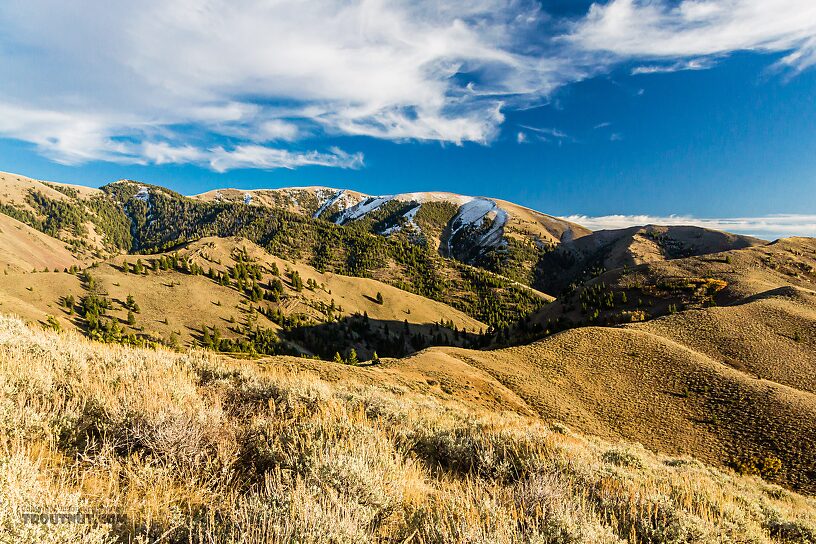
I saw few deer in the first evening, but one of them was a small buck, a mile away, at last light. In the morning I was positioned to look for him from up close:
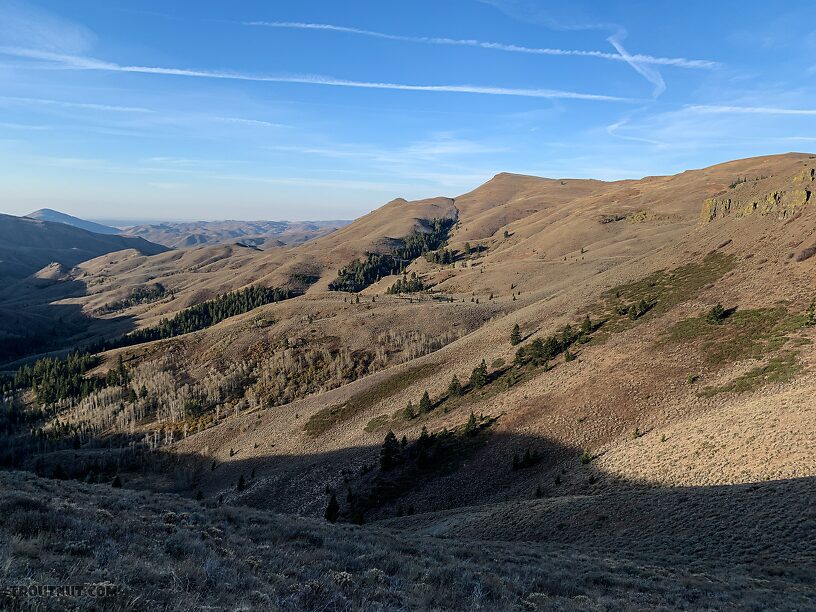
He was gone. Mid-morning, I spotted the best buck so far, not big but better than a yearling, with a group of does a mile away.
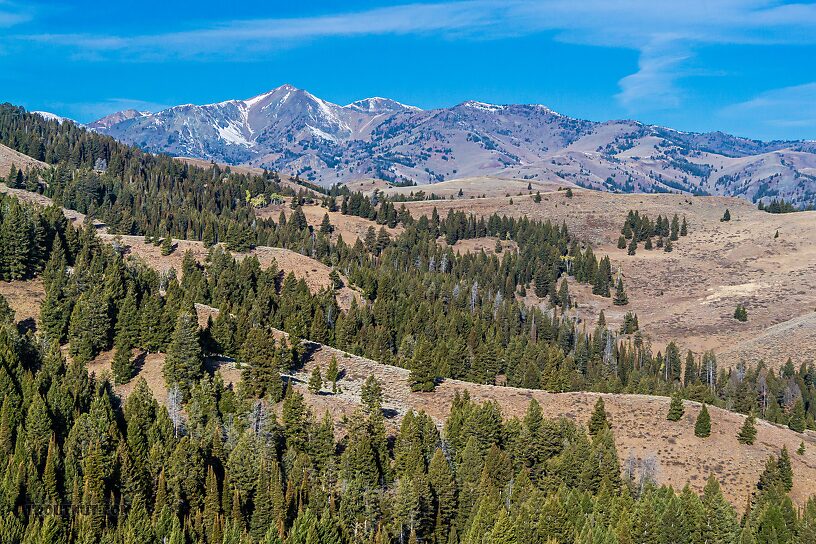
I hurried toward them, using the ridge to keep out of sight, stopping once half-way to glass and relocate them. They hadn't gone far. I took the long way around a hilltop to approach them with cover and wind in my favor, but when I got there, they were gone. I couldn't track them on such hard, rocky ground. I walked most of the way back to the road, glassed some new valleys at dusk (a few does, no bucks), and returned in the dark to sleep in the back of my Jeep again 14 hours after leaving it in the morning.
The next morning I slept until 8 and enjoyed breakfast from the warmth of my driver's seat while half-assed throwing up my binoculars just to not feel 100 % unproductive. There were three deer including a small buck, just about to disappear over a ridge a few hundred yards off the road. I followed them up the ridge and didn't see them from the top but there was another deer in the next shaded valley. I couldn't make out antlers, so I pressed ahead to find the ones I was after. This spooked that "doe," who ran into sunlight that revealed a tiny forkhorn rack, then ran away. I relocate the deer I was following just as they were about to disappear around the tip of another ridge. I had the little buck in my crosshairs but never had a clean shot.
I moved yet over the next ridge and found them again, headed toward a small patch of aspens in the creek bottom. I had great cover to sneak up on them, but when I reached my would-be shooting position, I couldn't find them. I glassed and glassed a small patch of aspens until I was convinced the deer have moved on elsewhere out of sight, then hurried to reach the next viewpoint. That busted them out of those same aspens, and they were gone.
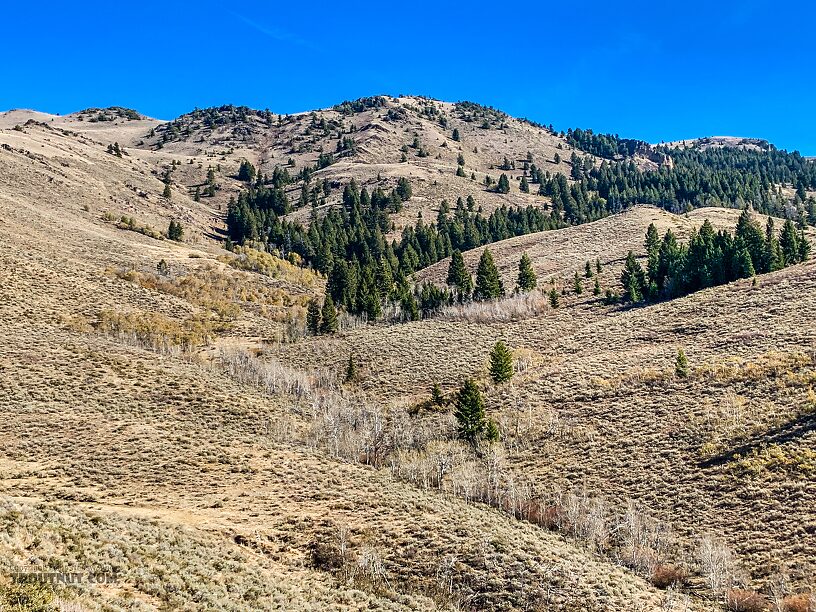
I once again left deer to find deer in a new area, settling for the evening on a view that looked promising, but had no deer.
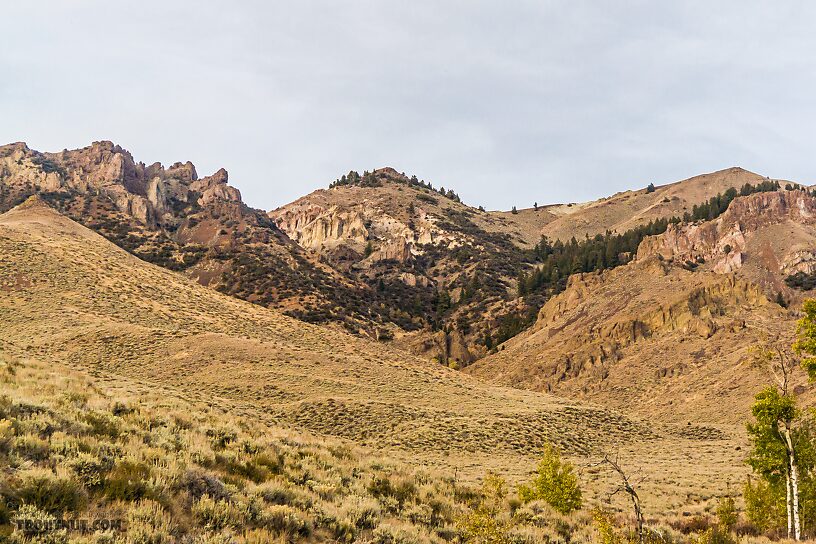
For the morning I moved slightly and saw a few does, but nothing to pursue.
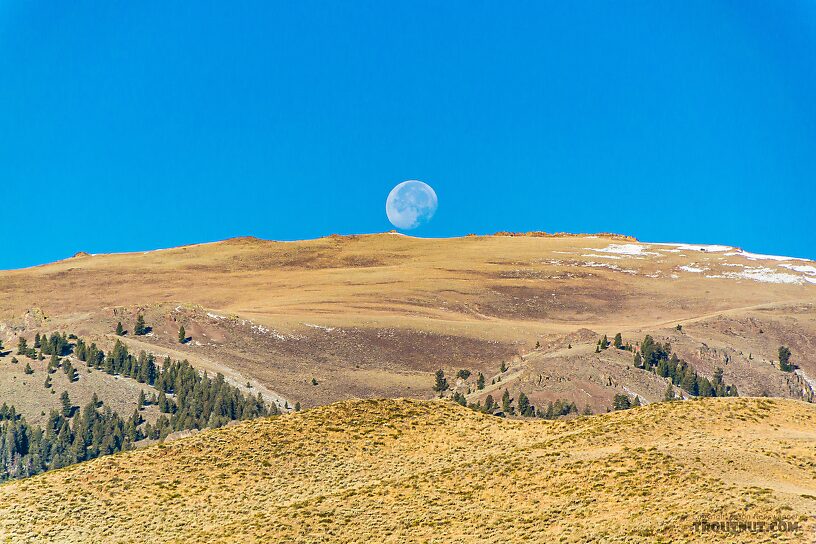
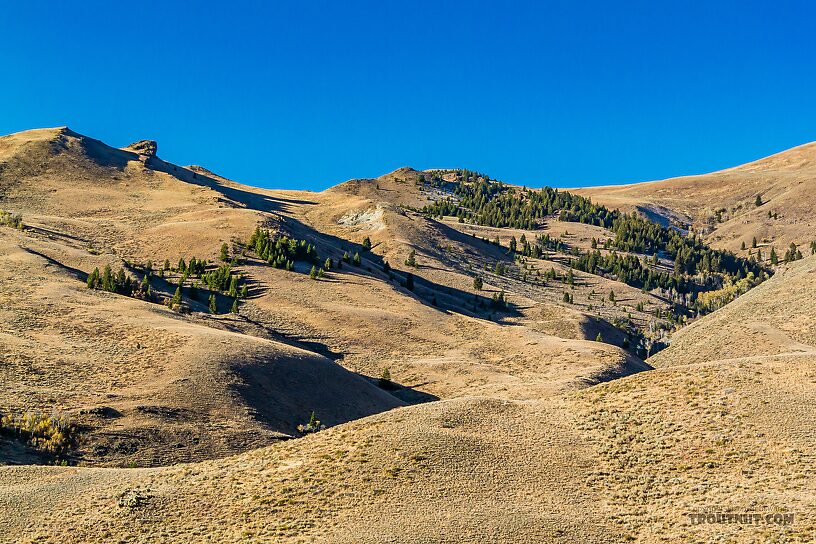
I did learn a valuable lesson about where not to put my knees when I settle into a glassing spot in the dark.
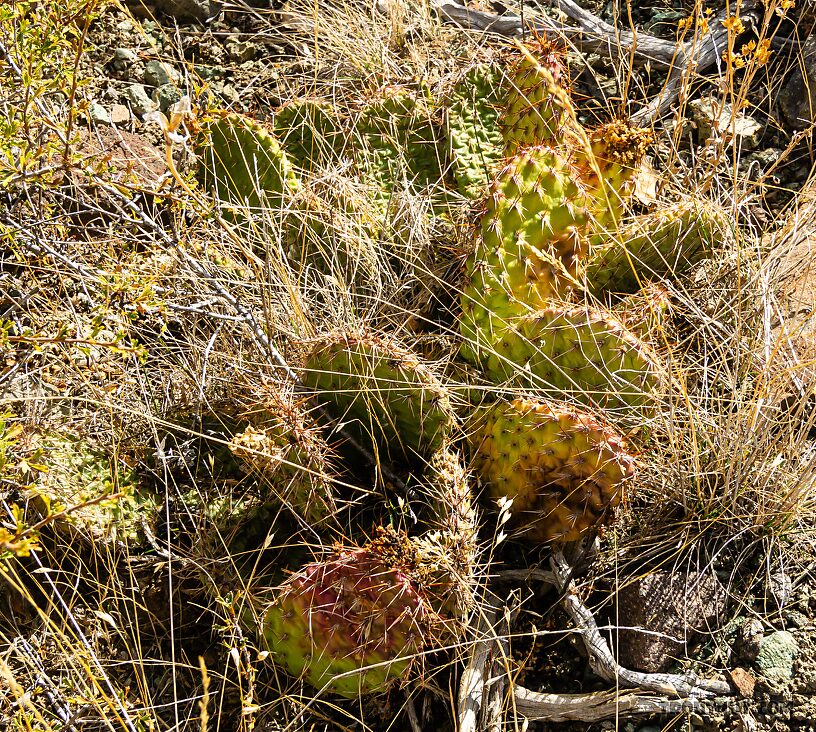
Next, I drove around the mountains and headed into a new spot with my backpacking gear. The terrain looked promising.
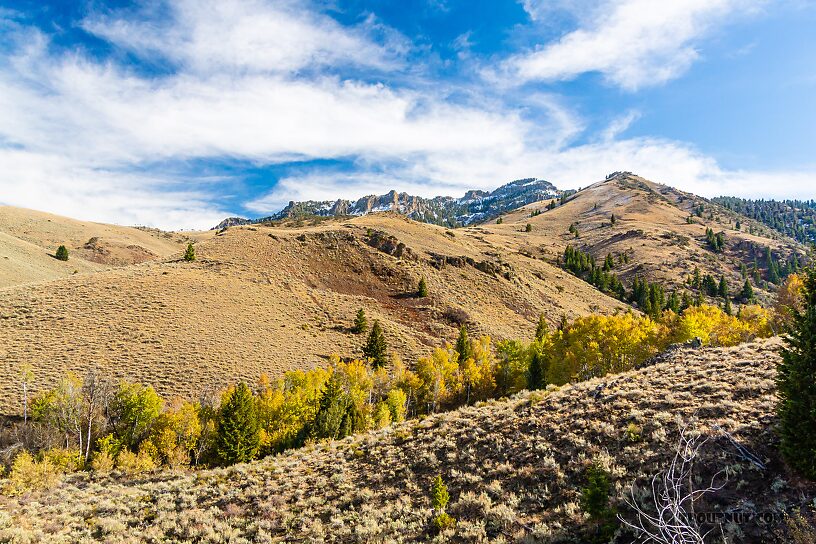
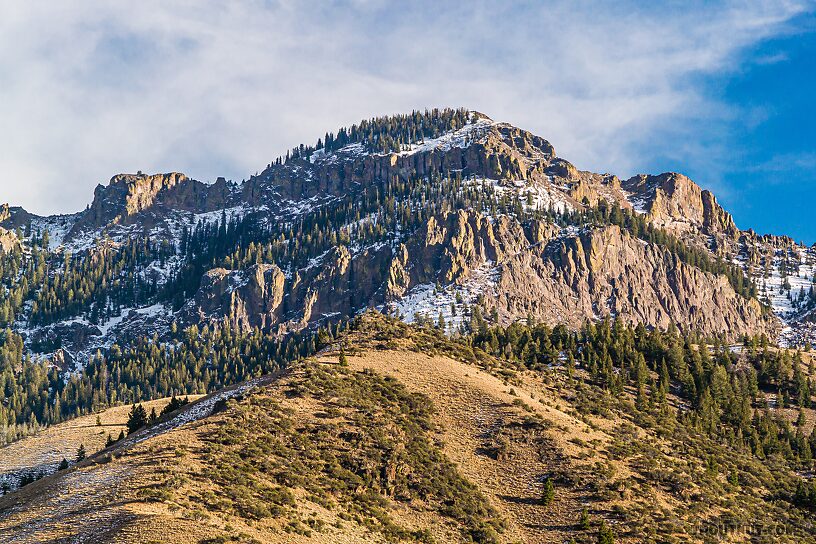
The deer did not agree. I didn't see a single one, morning or evening, so I cut the backpacking trip short. I went fishing for an evening, then drove half-way across the state to some completely different terrain.
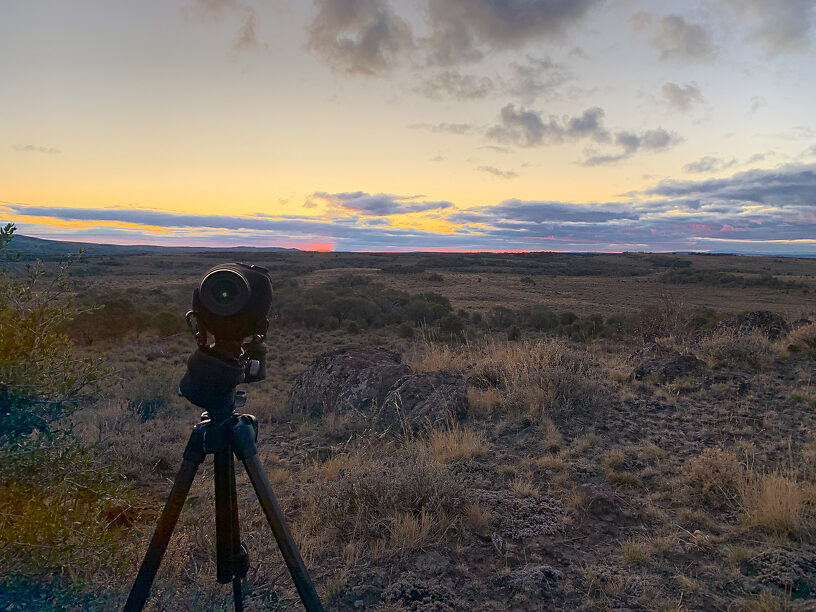
Glassing at first light, I spotted a group of does with a small buck in the distance, then royally screwed up by marking them at the wrong position on my map and stalking the wrong spot. By the time I found where they'd been, they were gone. I made a systematic loop sneaking around the places they might be, saving the best for last, with the wind in my favor... only to reach that spot and have a couple guys from Boise in blue jeans and flannel come traipsing out of timber saying, "We just spooked some deer!"
Frustrated by my mistake and theirs, I returned to my glassing spot near noon. I expected nothing, but somehow there was a mature buck out in the open! This was in a unit where the general season is only open for 2-point bucks, but my spotting scope confirmed the best: it was a big-bodied, mature 2x2. And at about 400 yards away I could quickly sneak in with cover and wind in my favor. This felt like it would finally be my payoff for persisting after so many close failures.
I made that stalk, and the buck was gone. I glassed and glassed the mahogany where it might have bedded, but I couldn't find it, and I thought it might have fed around the ridge. Should I stay and wait in case it bedded, or go looking for it? I went looking. I zigged when I should have zagged. I busted it out of that mahogany at around 100 yards and it bounded off into the distance without presenting a shot.
That last failure, on the ninth day of hunting, really broke my will to continue, and my wife was getting impatient back home. It was time to give up, but I'm going back in 2020 with a better idea of how to research and plan for the area.
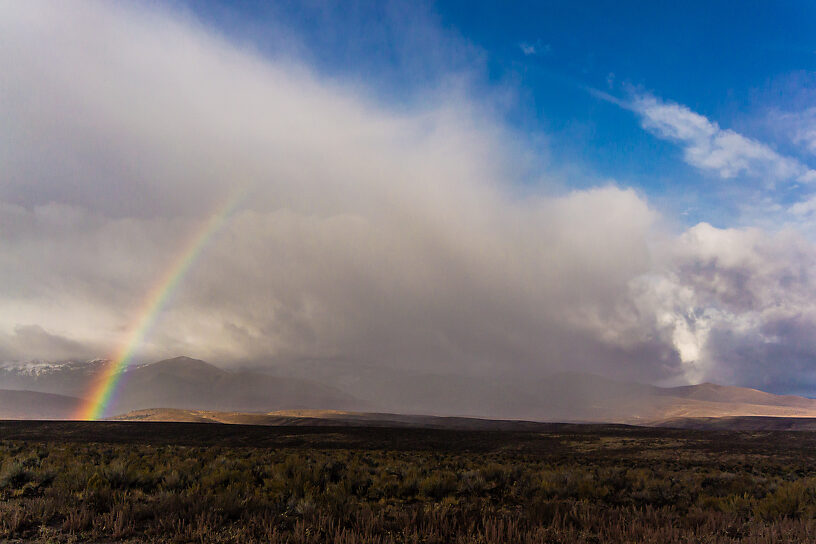
I learned from a lot of blunders on this trip, and I realized that I'm never going to figure out from Google Earth alone which places I'll glass up 20 does in an evening and which will be devoid of deer, because some of that country looked the same to me. If anyone recognizes that area and is up for sharing some tips (or just ruling out some bad ideas), I'm all ears.
Edit: With admin permission to post the link, here's the more detailed, photo-heavy version of this report on my website.
In 2019, I went to Idaho, still looking for my first mule deer. I started with three plans I'd researched through Google Earth, OnX, and the IDF&G website. Each plan was for a loop I could backpack over several days in remote terrain. None of the plans survived first contact with reality.
The first plan was to hunt a recent burn, up a small drainage with no official trail, where I was pretty sure I could get away from people on opening weekend.

I camped the night before the opener, a few miles from the road, on a ridge with these views:


With all that country to glass at first light, I only saw two deer, too briefly to tell if either was a buck. It looked like good habitat, but deer just weren't there--only elk. That one night with temperatures near zero convinced me it was not worth backpacking all over this basin just to see two deer per day. Later on, some hunters on the other side of the mountain confirmed that I was deer hunting in an elk spot.
Maybe the lack of open patches of sagebrush was a sign that I wasn't in good mule deer country, at least in that area. Everything else seemed right. However, I realized it was not smart to commit to backpacking into an area without learning more about it deer potential than I could glean from aerial photos alone. I ditched my other two plans and spent too much time over the next few middays sitting on the computer in a restaurant, redoing my e-scouting from scratch with a focus on sampling new areas until I found deer.
The next spot I tried, just for a morning of glassing, was a small alpine basin nobody had visited yet during rifle season.

There was no sign of deer, even does, to lure me up toward the top for a better view. I drove around and scouted some more.

I settled on hunting an area with small mountains of open sage country with patchy evergreens. I finally started finding deer in decent numbers, mostly does.

I spotted the first buck of the trip feeding in the valley near dark, and I didn't have enough shooting light to close the distance. I found him from the same spot the next morning, higher on the same ridge:

He wasn't large, just a 3x3 and maybe a big yearling, but I would be happy with any legal buck. I couldn't just walk straight at him across the valley, so I waited until the buck had disappeared behind some of those big trees and hadn't come out over over half an hour. Then I drove to a different access point and hiked three miles around the ridge to sneak up from a concealed position above the deer. Views from the ridge were nice:

I arrived where the deer was supposed to be and snuck in quietly, removing my boots like a bowhunter, because the terrain would put me within bow range before I had a line-of-sight. The tree never saw me coming. I don't know what the buck would have seen, because it turned out he never bedded there in the first place, but had slipped away hours earlier through a dip in the terrain that wasn't noticeable from afar.
I wasn't sure where to go next. I wanted to hunt harder, but in this area, hiking farther only meant getting closer to trails guys were hunting by horseback and ATV. So I disobeyed the advice I've heard on various podcasts -- "don't leave deer to find deer" -- and left to find some different deer.
For the next evening I picked an area with similar habitat to the last one.

I saw few deer in the first evening, but one of them was a small buck, a mile away, at last light. In the morning I was positioned to look for him from up close:

He was gone. Mid-morning, I spotted the best buck so far, not big but better than a yearling, with a group of does a mile away.

I hurried toward them, using the ridge to keep out of sight, stopping once half-way to glass and relocate them. They hadn't gone far. I took the long way around a hilltop to approach them with cover and wind in my favor, but when I got there, they were gone. I couldn't track them on such hard, rocky ground. I walked most of the way back to the road, glassed some new valleys at dusk (a few does, no bucks), and returned in the dark to sleep in the back of my Jeep again 14 hours after leaving it in the morning.
The next morning I slept until 8 and enjoyed breakfast from the warmth of my driver's seat while half-assed throwing up my binoculars just to not feel 100 % unproductive. There were three deer including a small buck, just about to disappear over a ridge a few hundred yards off the road. I followed them up the ridge and didn't see them from the top but there was another deer in the next shaded valley. I couldn't make out antlers, so I pressed ahead to find the ones I was after. This spooked that "doe," who ran into sunlight that revealed a tiny forkhorn rack, then ran away. I relocate the deer I was following just as they were about to disappear around the tip of another ridge. I had the little buck in my crosshairs but never had a clean shot.
I moved yet over the next ridge and found them again, headed toward a small patch of aspens in the creek bottom. I had great cover to sneak up on them, but when I reached my would-be shooting position, I couldn't find them. I glassed and glassed a small patch of aspens until I was convinced the deer have moved on elsewhere out of sight, then hurried to reach the next viewpoint. That busted them out of those same aspens, and they were gone.

I once again left deer to find deer in a new area, settling for the evening on a view that looked promising, but had no deer.

For the morning I moved slightly and saw a few does, but nothing to pursue.


I did learn a valuable lesson about where not to put my knees when I settle into a glassing spot in the dark.

Next, I drove around the mountains and headed into a new spot with my backpacking gear. The terrain looked promising.


The deer did not agree. I didn't see a single one, morning or evening, so I cut the backpacking trip short. I went fishing for an evening, then drove half-way across the state to some completely different terrain.

Glassing at first light, I spotted a group of does with a small buck in the distance, then royally screwed up by marking them at the wrong position on my map and stalking the wrong spot. By the time I found where they'd been, they were gone. I made a systematic loop sneaking around the places they might be, saving the best for last, with the wind in my favor... only to reach that spot and have a couple guys from Boise in blue jeans and flannel come traipsing out of timber saying, "We just spooked some deer!"
Frustrated by my mistake and theirs, I returned to my glassing spot near noon. I expected nothing, but somehow there was a mature buck out in the open! This was in a unit where the general season is only open for 2-point bucks, but my spotting scope confirmed the best: it was a big-bodied, mature 2x2. And at about 400 yards away I could quickly sneak in with cover and wind in my favor. This felt like it would finally be my payoff for persisting after so many close failures.
I made that stalk, and the buck was gone. I glassed and glassed the mahogany where it might have bedded, but I couldn't find it, and I thought it might have fed around the ridge. Should I stay and wait in case it bedded, or go looking for it? I went looking. I zigged when I should have zagged. I busted it out of that mahogany at around 100 yards and it bounded off into the distance without presenting a shot.
That last failure, on the ninth day of hunting, really broke my will to continue, and my wife was getting impatient back home. It was time to give up, but I'm going back in 2020 with a better idea of how to research and plan for the area.

I learned from a lot of blunders on this trip, and I realized that I'm never going to figure out from Google Earth alone which places I'll glass up 20 does in an evening and which will be devoid of deer, because some of that country looked the same to me. If anyone recognizes that area and is up for sharing some tips (or just ruling out some bad ideas), I'm all ears.
Edit: With admin permission to post the link, here's the more detailed, photo-heavy version of this report on my website.
Last edited:
